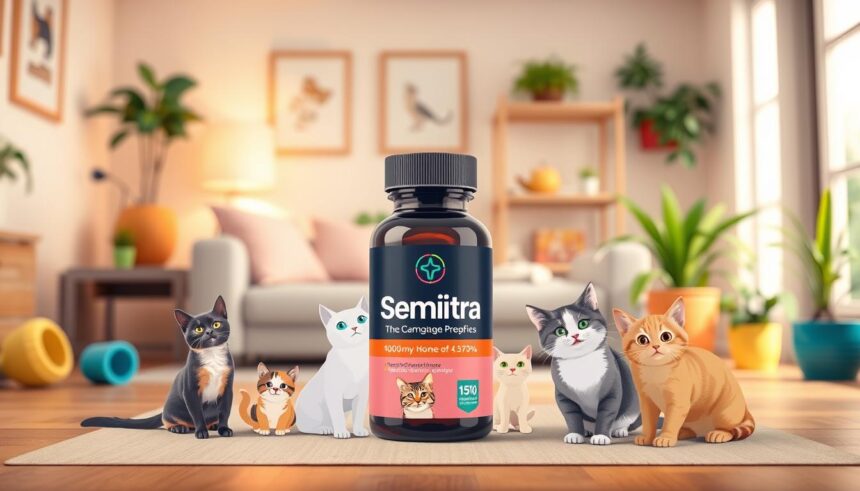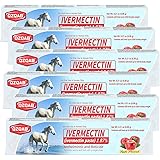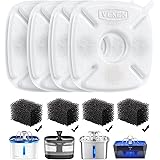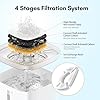Did you know Semintra is the first FDA-approved cat blood pressure medication? It contains telmisartan. High blood pressure can harm organs like the eyes, kidneys, heart, and brain. Semintra helps manage this condition, which is vital for your cat’s health.
Understanding Semintra’s benefits is key for cat owners. It reduces protein leakage in the urine and lowers kidney blood pressure. This is crucial for your cat’s well-being.
As a cat owner, knowing about Semintra is important. It keeps your pet healthy. For more on cat health, visit catsjoys.com/drontal-for-cats. Semintra relaxes blood vessels, lowering kidney blood pressure and reducing urine protein leakage.
Semintra is an oral solution with 10 mg/mL telmisartan. It’s an angiotensin II receptor blocker. Humans have used it since the mid-1990s. The FDA approved it for cats with high blood pressure.
Key Takeaways
- Semintra is the first FDA-approved medication to control high blood pressure in cats.
- The active ingredient in Semintra is telmisartan, an angiotensin II receptor blocker.
- Semintra for cats is essential for managing feline hypertension and reducing protein leakage into the urine.
- The benefits of semintra for feline hypertension include decreasing blood pressure in the kidneys.
- Regular monitoring of blood pressure, kidney function, and urinary protein loss is advised to evaluate the effectiveness of the medication.
- Semintra is available in various formulations, including 20 mg, 40 mg, and 80 mg tablets, as well as an oral solution.
What is Semintra for Cats?
Semintra is a special medicine for cats. It has 10 mg/mL telmisartan, which is a type of blocker. This helps manage high blood pressure in cats.
The main ingredient, telmisartan, makes blood vessels relax. This action lowers blood pressure and stops too much protein from leaking into the urine.
When it comes to semintra dosage, it’s important to follow the guidelines. This helps avoid semintra side effects. The medicine comes in a form that’s easy to give to cats.
It’s important to keep Semintra in a cool place. Store it at or below 25°C (77°F). If the bottle is opened, use it within six months.
The right dose is 1 mg telmisartan per kilogram of body weight. This is about 0.25 ml per kilogram of body weight. However, Semintra is not safe for all cats.
It’s not safe for cats with liver disease or those under 9 months old. Knowing how to use Semintra and its possible semintra side effects helps cat owners and vets work together. This ensures the best care for cats.
How Semintra Works
Semintra is a medication that relaxes blood vessels. This action decreases blood pressure in the kidneys. It also reduces protein leakage into the urine. When administering semintra to cats, it’s key to know how it works.
Semintra contains telmisartan, an angiotensin receptor blocker (ARB). It blocks the action of angiotensin II, a strong vasoconstrictor. This is crucial for understanding Semintra’s impact on cat health.
The impact of Semintra on cat health is significant. It reduces the risk of kidney damage, heart disease, and other complications. To answer the question of how does semintra work, it’s important to look at the renin-angiotensin-aldosterone system (RAAS). Semintra inhibits the RAAS, decreasing aldosterone production. Aldosterone regulates electrolyte balance and blood pressure.
| Strength | Indication | Dosage |
|---|---|---|
| 4 mg/ml | Reduction of proteinuria associated with chronic kidney disease (CKD) | 1 mg of telmisartan per kg of body weight, equivalent to 0.25 ml per kg of body weight |
| 10 mg/ml | Treatment of systemic hypertension | Recommended dosage: 1 mg of telmisartan per kg of body weight, equivalent to 0.25 ml per kg of body weight |
Regular blood pressure checks by veterinarians are necessary after starting Semintra. This helps adjust the dose as needed. By understanding how does semintra work and following guidelines for administering semintra to cats, cat owners can manage their pet’s hypertension. This reduces the risk of related complications.
Conditions Treated by Semintra
Semintra is mainly used for cats with high blood pressure. This condition can harm their kidneys and heart. It helps lower blood pressure in cats within two weeks.
Studies show that up to 74% of cats with high blood pressure also have kidney disease. And, up to 65% of cats with kidney disease have high blood pressure.
This medication also helps manage chronic kidney disease. It’s a condition where the kidneys slowly lose function. Semintra may also treat proteinuria, which is too much protein in the urine. Regular blood pressure checks by veterinarians are key to adjusting the dosage. This ensures the cat’s blood pressure stays within a healthy range.
- Initial dosing involves administering the medication twice daily for 14 days, followed by once daily for continued management.
- Common side effects reported in cats receiving semintra include vomiting, diarrhea, and decreased activity levels.
- Veterinarians should monitor for potential worsening of kidney values in cats with pre-existing kidney disease during the initial treatment phase.
Semintra is a good choice for treating high blood pressure and kidney disease in cats. It offers many benefits for cat owners looking to manage their pet’s health.
Dosage and Administration
When giving Semintra to cats, it’s key to stick to the semintra dosage guidelines. This ensures the medication is used safely and effectively. The first dose is 1.5 mg/kg (0.68 mg/lb) twice a day for 14 days. Then, the dose goes up to 2 mg/kg (0.91 mg/lb) once a day.
It’s important to give Semintra to cats the right way to avoid side effects. You can put it in their mouth or mix it with a bit of food. Also, keep an eye on your cat’s blood pressure to make sure the medicine is working right.
The dose of Semintra might change based on how your cat reacts. Always talk to your vet to find the best treatment plan. By following the semintra dosage guidelines and giving the medicine correctly, you help your cat get the most out of the treatment.
Recommended Dosage Guidelines
- Initial dose: 1.5 mg/kg (0.68 mg/lb) orally twice daily for 14 days
- Maintenance dose: 2 mg/kg (0.91 mg/lb) orally once daily
- Dose adjustments: may be necessary based on your cat’s response to the medication
How to Administer Semintra Safely
To safely give Semintra, follow the dosage guidelines and take steps to avoid side effects. This means watching your cat’s blood pressure and working with your vet to adjust the dose if needed.
Potential Side Effects
Semintra can cause side effects in cats. Knowing these can help keep your cat healthy. Common side effects of Semintra include vomiting, diarrhea, and feeling tired. Cats may also lose weight, have anemia, or get dehydrated.
Some cats might not want to eat, have low blood pressure, or feel very tired. Watching your cat closely while they take Semintra is key. Tell your vet right away if you see any bad reactions. Regular vet visits and tests are also important.
In rare cases, Semintra can lead to serious issues like extreme tiredness and collapse. If you see these signs, get help from your vet fast. They will help find the best way to treat your cat and avoid side effects.
To lower the chance of side effects, stick to the dosage your vet says. Also, keep an eye on your cat’s blood pressure, kidney health, and urine protein. This can help catch problems early.
Monitoring Your Cat’s Health
It’s important to keep an eye on your cat’s health when they’re on Semintra. This means monitoring cat health by taking them to the vet regularly. These visits help spot any side effects or problems early, so your cat gets the best care.
Watch out for signs like mild vomiting and diarrhea, which happen in less than 1 in 1000 cats. Other side effects, though rarer, include higher liver enzymes, mild anemia, or changes in kidney enzymes. If you see any of these, talk to your vet right away.
Your vet might suggest blood tests, urine analysis, and blood pressure checks. These tests check if the treatment is working and catch any issues early.
| Side Effect | Frequency |
|---|---|
| Mild vomiting and diarrhea | Less than 1 in 1000 cats |
| Increased liver enzymes | Less than 1 in 10,000 cats |
| Mild anemia | Less than 1 in 10,000 cats |
By teaming up with your vet and monitoring your cat’s health often, you can make sure your cat does well on Semintra.
Combining Semintra with Other Medications
When thinking about mixing Semintra with other meds, talking to a vet is key. They check if Semintra and other meds, like prescriptions or supplements, can work well together. This helps avoid bad reactions and makes sure the treatment works best.
The product info says mixing Semintra with other meds is complex. The vet will look at the good and bad sides of mixing them. They consider the cat’s health and past medical issues.
Important things to think about when mixing Semintra with other meds include:
- How Semintra might react with other meds, like blood pressure meds or kidney meds
- The chance of side effects, like stomach problems or changes in red blood cells
- The effect on the cat’s overall health and happiness
To keep things safe, it’s important to listen to the vet’s advice. Watch your cat’s health closely when they’re on Semintra and other meds. This way, you can reduce the risk of bad side effects and help your pet get better.
Frequently Asked Questions about Semintra
As a cat owner, you might wonder about Semintra, a drug for high blood pressure in cats. The semintra faq section aims to answer your questions. It’s good to know that Semintra is effective in controlling hypertension in cats.
Many ask about Semintra’s side effects for cats. While it’s usually safe, some cats might get diarrhea, vomit, or lose their appetite. Keep an eye on your cat’s health and talk to your vet if you’re worried.
It’s also key to know how to give Semintra to your cat safely. The drug starts working in 1 to 2 hours and lasts about 24 hours. Always get advice from your vet on how to administer it.
Remember to store Semintra in its original bottle at room temperature. Keep it away from kids and pets. Also, be aware of any drug interactions. By following these tips and talking to your vet, you can ensure your cat gets the best care with Semintra.
Cost and Availability of Semintra
When thinking about using Semintra for your cat, the semintra cost is key. The price can change based on the dosage and how often you give it. On average, it’s about $134.99. New customers get a 40% discount, up to $40, with Autoship.
To buy semintra for cats, you need a vet’s prescription. It’s only available by prescription and can be bought from a vet or an authorized pharmacy.
Some important things to remember when buying Semintra include:
* Cats start with 1.5 mg/kg (0.68 mg/lb) twice a day for 14 days
* For maintenance, they need 2 mg/kg (0.91 mg/lb) once a day
* You can reduce the dose by 0.5 mg/kg (0.23 mg/lb) steps down to 0.5 mg/kg (0.23 mg/lb) once a day
It’s vital to stick to the dosage and how often to give it as directed. Always talk to your vet for the best advice on using Semintra for your cat.
Alternatives to Semintra
Semintra is a common drug for cat hypertension. But, there are other options. Cat owners might look into ACE inhibitors and calcium channel blockers. These can help lower blood pressure and improve health.
Changing your cat’s lifestyle can also help. Try a low-sodium diet and more playtime. These steps can help manage blood pressure and health.
Other Medications for Cat Hypertension
Medicines like amlodipine and enalapril can also treat cat hypertension. They relax blood vessels and lower blood pressure. Always talk to a vet to find the right treatment for your cat.
Lifestyle Changes to Consider
Changing your cat’s lifestyle is key too. Make sure their environment is calm, they get enough exercise, and eat well. These steps can help lower blood pressure and improve health.
Working with a vet is important to find the best Semintra alternatives. They can help create a plan that includes medication and lifestyle changes. This way, you can give your cat the best care for managing hypertension.
The Importance of Veterinary Guidance
When treating cat hypertension with semintra for cats, getting vet help is key. A vet will diagnose, prescribe, and watch the cat’s health. It’s important to see a vet if the cat has bad reactions or if the meds don’t work.
Vets play a big role in treating cats. They check the cat’s health, choose the best treatment, and teach owners how to manage hypertension. Regular vet visits are crucial to see if the treatment is working and to adjust it if needed.
Some important things vets do for cat owners include:
- Checking the cat’s blood pressure and kidney function regularly
- Changing the semintra dosage if needed
- Helping with diet and lifestyle changes for better health
By following the vet’s advice and working together, cat owners can give their pets the best care for hypertension.
Success Stories: Semintra in Action
Semintra has greatly helped many cats with high blood pressure. Semintra success stories show how it lowers blood pressure and improves cat health improvement. For example, a study on telmisartan’s effects on blood pressure in healthy cats proves its worth.
Real-life stories from cat owners also show Semintra’s positive effects. Cats with chronic kidney disease have seen their condition improve. These semintra success stories highlight its role in bettering cat health improvement.
Though every cat reacts differently to Semintra, the evidence supports its use. We share these stories to highlight the importance of treating hypertension in cats. Semintra is a key part of cat health improvement.
Conclusion: Making Informed Choices
Semintra is a great medicine for cats with high blood pressure. It helps keep their heart healthy. By knowing the good and bad of semintra for cats, owners can choose the best for their pets.
Final Thoughts on Semintra for Cats
Semintra has grown stronger, from 4 mg/ml to 10 mg/ml. This makes it even more useful for cats. The European Medicines Agency approved this stronger version in 2018.
Promoting the Health of Your Feline Friend
Watching your cat’s health closely is key. Look out for any side effects and talk to your vet. Regular vet visits and quick action on symptoms are crucial. Also, being open to other treatments helps keep your cat healthy.






























































